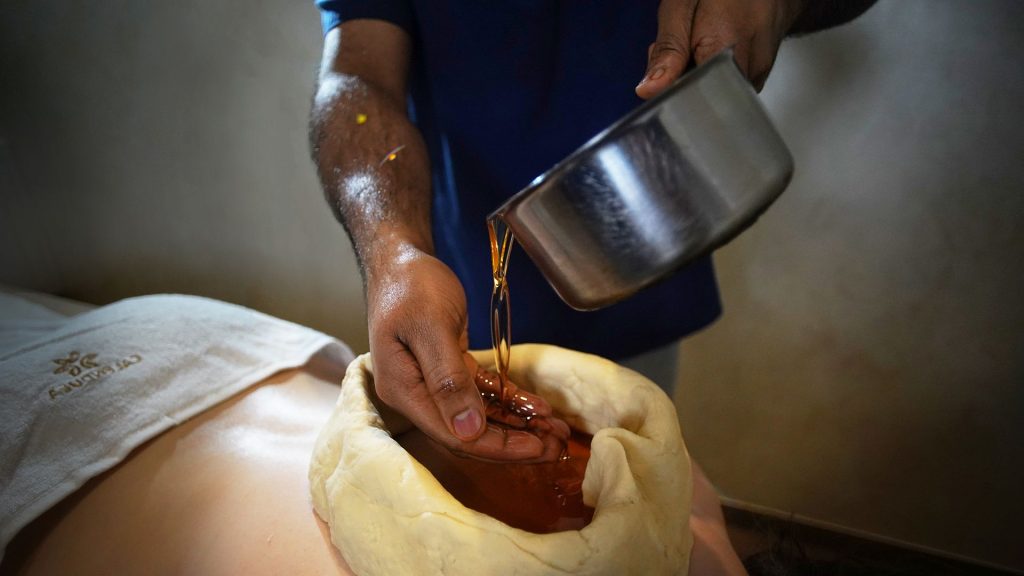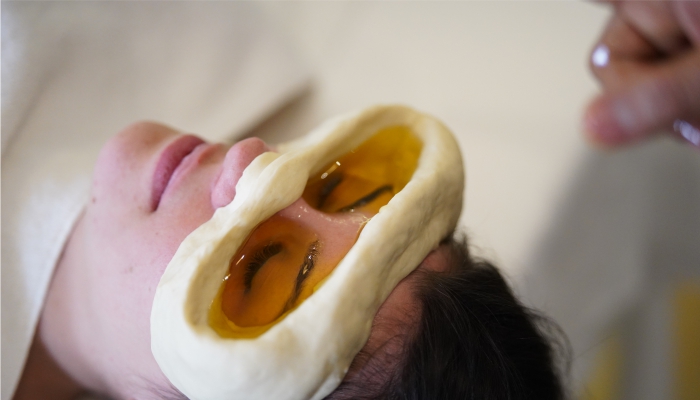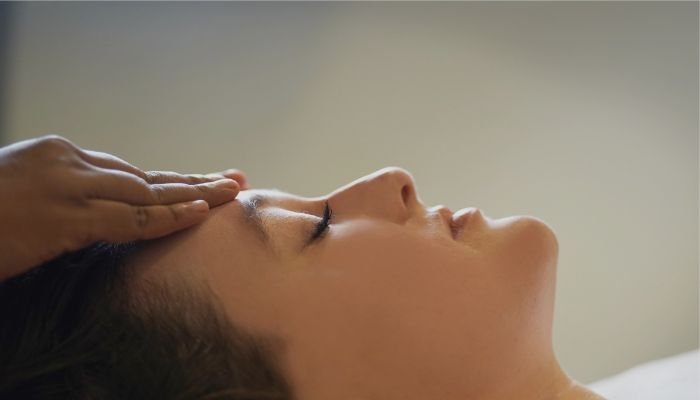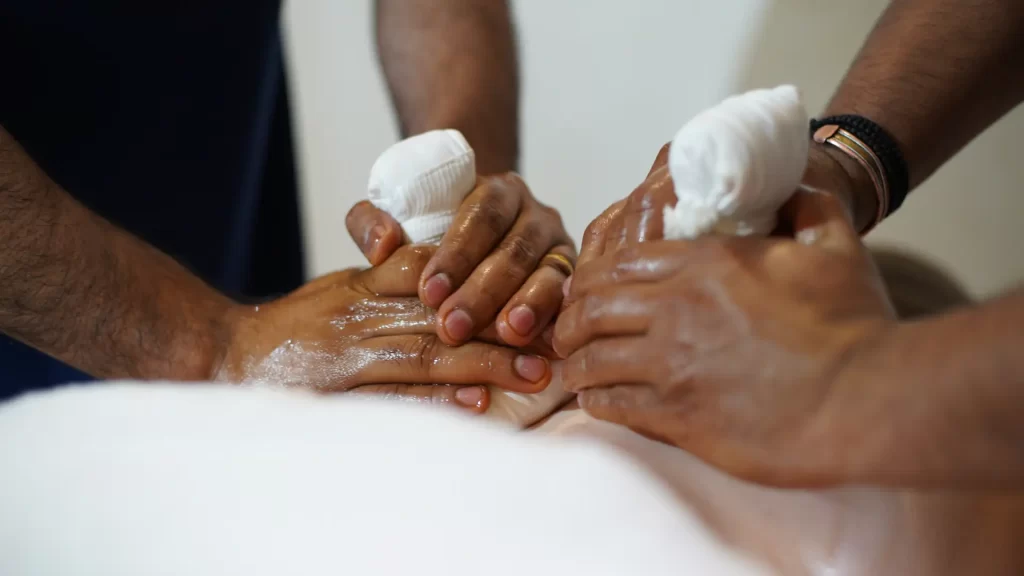WHAT IS INCLUDED IN
Ayurvedic healing?
Methods of Ayurvedic Healing
Ayurvedic healing is based on the thousands of years of traditional Chinese medicine, which has been validated by the experience of numerous generations. The methods of Ayurvedic healing are diverse, targeting different parts of the body and applied for various indications. Ayurvedic healing is based on two types of treatment methods:
- The Shamanic Chikitsa, or symptomatic treatments, aim to alleviate the symptoms of the disease and improve overall well-being, but they do not address the root cause of the illness.
- The Shodhana Chikitsa, or disease eradication, aims to eliminate the disease caused by an excess of the "ama" dosha. When it reaches a critical point, Panchakarma treatment or other Ayurvedic therapies are used to remove it.

Panchakarma Treatment
Panchakarma is a Sanskrit term where „pancha” means five and „karma” means action, consisting of five purification procedures. The first, Vamana, is a therapeutic vomiting that helps eliminate excess mucus and toxins from the respiratory system, as well as the nasal and oral cavities. The second, Virechana, is a purgative therapy targeting the digestive system, particularly the liver and small intestine, to eliminate excess bile. The Nasya procedure involves cleaning the nasal and oral passages with plant-based medicinal preparations and inhalation. Vasti is an enema treatment where herbal oils and other natural solutions are used to cleanse the large intestine. Finally, there is Rakta Moksha, which purifies the blood through bloodletting in certain cases, aiding in the body’s detoxification and regeneration.
Rasayana, a rejuvenating and healing treatment
Ayurvedic Rasayana is an in-depth regeneration and rejuvenation program aimed at maintaining health, ensuring longevity, and achieving physical and mental balance. The word „Rasayana” means „the path of essence,” focusing on the renewal of life energies, strengthening the immune system, and slowing down the aging of cells.
The program involves the use of various herbs, minerals, and customized nutritional plans, all aimed at detoxifying the body, regenerating tissues, and restoring mental freshness. Rasayana often combines body treatments, such as oil massages and internal detoxification regimens, with specialized diets and lifestyle recommendations to enhance vitality and preserve youthfulness. This comprehensive therapy is a significant part of Ayurvedic treatments, helping achieve inner harmony and a long, healthy life.

Ayurvedic Massages
Ayurvedic massage is a therapeutic treatment based on ancient Indian medical traditions, aimed at achieving harmony between the body and mind. These types of massages use a combination of special oils, herbal pouches, and techniques to stimulate the body’s energy flow, relieve accumulated stress, and strengthen the immune system. The goal of Ayurvedic massage is the complete renewal and energizing of the body, while promoting the body’s self-healing mechanisms.The Abhyanga Massage
The Abhyanga massage is a traditional oil-based Ayurvedic massage. During the Abhyanga massage, carefully prepared herbal oils are rubbed into the skin using special techniques. The massage movements of Abhyanga extend from the head down to the feet. The combination of oil and massage enhances peripheral circulation, which improves the absorption of active ingredients, directing them to the necessary organs through the blood and lymphatic systems.Pad Abhyanga Massage
Pad Abhyanga is an oil massage for the legs that helps improve soft tissues and joints, enhances vision, maintains eye health, and controls the Vata dosha. This type of Ayurvedic massage alleviates leg pain, activates the immune system, improves hearing perception, relieves restless leg syndrome (Willis-Ekbom disease), eases PMS symptoms, and reduces numbness or cramping sensations in muscles, tendons, and nerve endings.Shiro Abhyanga Massage
Shiro Abhyanga is an Ayurvedic head massage that alleviates muscle tension accumulated in the neck, shoulders, face, and head. The scalp and hair are massaged with a specially selected oil, and the rubbing gradually transitions into a more refined massage throughout the treatment. The Shiro Abhyanga massage improves blood circulation to the brain, relieves headaches, insomnia, enhances memory, and provides vitality and energy for daily life.How Does Abhyanga Massage Help?
Regular oil massage strengthens the immune system, improves digestion, normalizes bowel movements, rejuvenates the body, helps smooth out wrinkles, and prepares the body for detoxification.Udvartana Massage
Udvartana is an intensive, abrasive full-body massage using herbal powders that help cleanse the pores of the skin and contribute to the deep absorption of the herbs’ active ingredients through the skin. This type of treatment is used for an imbalanced Kapha dosha (swelling, obesity, carbohydrate, and fat metabolism disorders). The massage movements extend from the head to the feet. This procedure has an exfoliating effect, improving the texture of the skin and restoring the normal tone of the muscles and ligaments.Marma Massage
The Marma Ayurvedic massage targets biologically active zones (marmas) that cover the body’s vital centers. These marmas are connected by nearly 350 nadis (channels). During the Marma massage, the therapist redistributes and balances the energy affecting the marmas, harmonizing the body’s energy flow.Patra Potli and Pinda Svedana Ayurvedic Massages
Patra Potli and Pinda Svedana are types of Ayurvedic massages in which special pouches filled with medicinal herbs, cereals, or heated oils are used to vigorously massage and rub the entire body. The contents of the pouches may vary depending on the patient’s constitution, accompanying symptoms, and the goal of the treatment. Compared to the Abhyanga massage, these are more intense Ayurvedic massages, during which the slightly heated oil-filled pouches are gently tapped and rubbed on the body. This type of treatment helps accelerate metabolism in skin cells, subcutaneous fat, and muscle tissue. The Patra Potli massage also helps open pores, treating weak muscles and joints. These Ayurvedic massages are effective in treating rheumatism, spinal diseases, neuralgia, and paralysis affecting certain parts of the body.Pichizyl Massage
Pichizyl is a type of Ayurvedic massage in which the therapist uses 4-5 liters of medicinal oil for the treatment. The oil is poured onto the body in a special manner, and then gently massaged into the skin with smooth movements. The procedure has therapeutic and rejuvenating effects and is used to treat Vata dosha imbalances (nervous system disorders, joint diseases, paralysis).
Ayurvedic treatments involving heat
Svedana Treatment
Svedana is a heating process carried out in a special steam chamber, where herbal steam mixtures are used. The process induces intense sweating, which allows toxins to be removed from the body through the skin. Sweating helps balance the Vata and Kapha doshas, opens the body’s channels, enhances circulation, improves metabolism, and increases the level of agni (digestive fire). After the Svedana treatment, the color and condition of the skin improve. There are more than 20 types of healing Svedana, but three are practiced most frequently, which are also available at the Calendula Clinic.Prastara Svedana (Indian Steam Bath)
Prastara Svedana is the process where the patient sits inside a structure resembling a box, with the head remaining outside. Herbal vapors are released inside (the infusions are prepared based on a specific dosha constitution or imbalance). During the steam bath, a cold compress is placed on the head to prevent overheating and dizziness. During the procedure, the patient drinks herbal tea to avoid dehydration. The temperature inside the Svedana is 35°C. The duration of the treatment is 10-30 minutes (as prescribed by the doctor).Shankara Svedana Treatment
At our clinic, Shankara Svedana, a heating process using pouches filled with medicinal preparations, is also part of certain Ayurvedic treatment programs.Medical Compresses
Ayurvedic medicine also uses medical compresses for the treatment of diseases. Lepanam is an herbal paste that is applied to the affected area and then wrapped. It is useful for treating various types of inflammations, skin diseases, arthritis, and uratic arthritis.Thank You!
We have successfully recorded your pre-booking request!
Our colleagues will contact you soon!